November 29, 2024 · 14 min read
Data-Driven Approaches to Setting Agendas for Effective Committee Meetings

Shaimaa Badawi
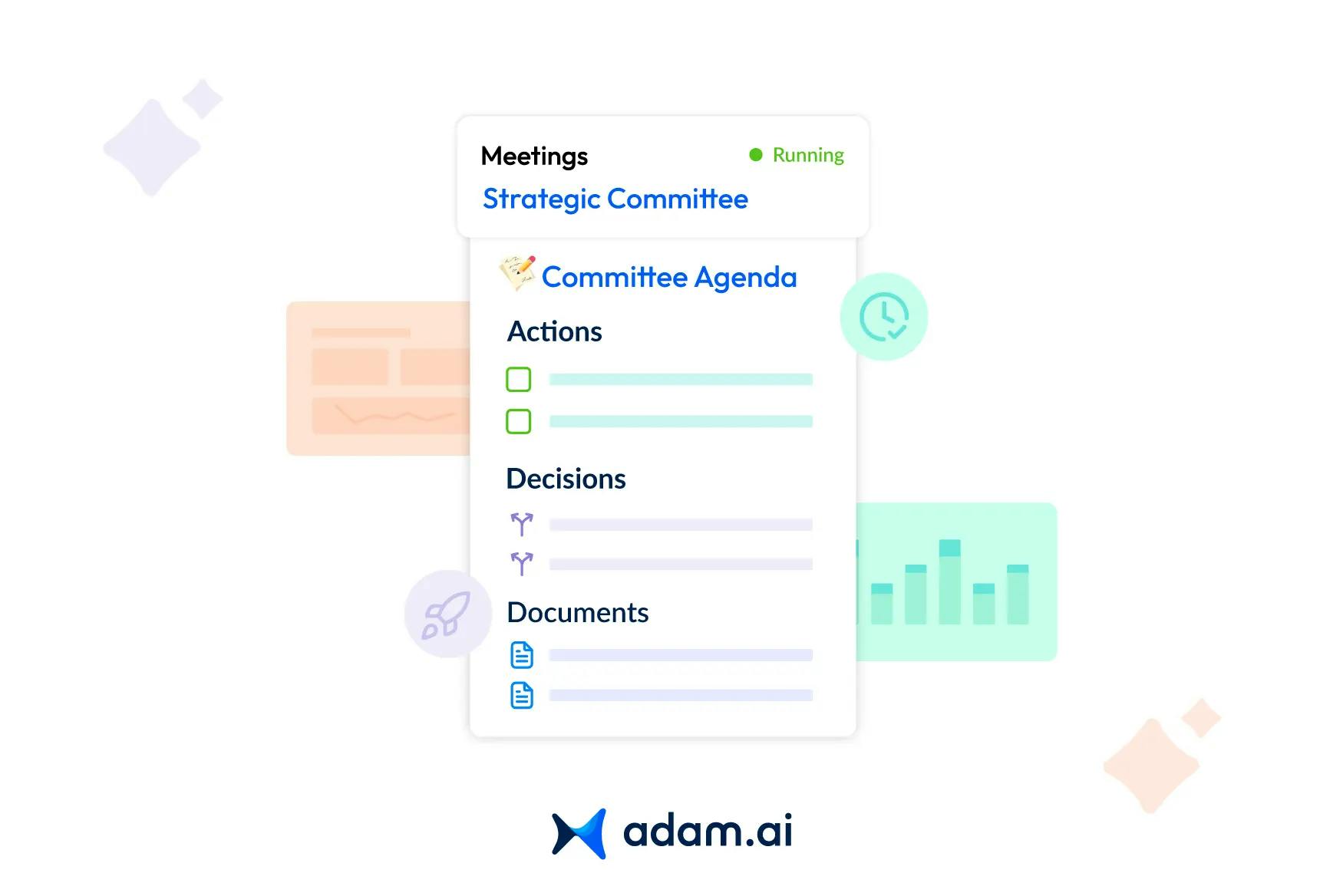
Crafting effective agendas requires insights that go beyond intuition, leveraging data to prioritize discussions, allocate time, and enhance inclusivity. This article explores the types of data committees can use, the challenges of implementing data-driven agenda-setting, and best practices for making your committee meetings more impactful.
What does it mean to take a data-driven approach to setting committee agendas?
Taking a data-driven approach to setting committee agendas involves using measurable insights and analytics to inform the structure, topics, and priorities of a meeting. Rather than relying solely on intuition or traditional practices, committees leverage data to create agendas that are objective, relevant, and focused on achieving actionable outcomes.
Key elements of a data-driven approach:
- Informed agenda topics
Data is used to identify high-priority issues, trends, or recurring challenges that need discussion. For instance, attendance records or previous meeting minutes might highlight unresolved topics or areas requiring urgent attention. - Optimized meeting time
Analyzing past meeting durations and participant engagement helps allocate appropriate time for each agenda item. This ensures discussions remain concise while providing enough depth for meaningful outcomes. - Stakeholder input analysis
Feedback and input from committee members are analyzed to incorporate diverse perspectives. This could include surveys, polling data, or shared documents that highlight pressing concerns or innovative ideas. - Enhanced decision-making
Data ensures that agenda items are aligned with measurable goals, such as strategic objectives or performance benchmarks. This approach prioritizes decisions backed by factual evidence rather than subjective opinions. - Continuous improvement
Committees use meeting analytics to evaluate the effectiveness of past agendas, such as tracking the completion rate of action items or analyzing participant feedback. This iterative process refines future agendas, making them more effective over time.
Why is data essential for creating effective committee agendas?
Data is a cornerstone of creating effective committee agendas because it provides objective insights that enhance focus, efficiency, and decision-making. Without data, agenda-setting can become arbitrary, overlooking critical priorities or mismanaging meeting time. Here’s why data is indispensable:
1. Prioritizing critical issues
Data allows committees to identify and prioritize the most pressing topics for discussion. For example, performance reports, project updates, or unresolved issues from previous meetings can highlight what needs immediate attention.
2. Improving meeting efficiency
Analyzing data on past meeting durations, attendance, and engagement levels helps committees allocate time effectively for each agenda item. This ensures discussions are thorough yet concise, avoiding overlong or unproductive meetings.
3. Aligning with strategic goals
Data ensures that agenda items align with organizational objectives. For instance, metrics such as key performance indicators (KPIs) or progress toward strategic goals provide a framework for setting actionable agenda points.
4. Enhancing decision-making
Objective, data-driven insights support evidence-based discussions and decisions. Committees can use reports, analytics, or stakeholder feedback to back proposals, increasing the credibility and impact of their decisions.
5. Ensuring inclusivity
Data on participation levels or stakeholder contributions helps ensure everyone’s voice is heard. Committees can use this information to balance agenda topics, giving space for diverse viewpoints and fostering equitable decision-making.
6. Tracking progress and accountability
Data from previous meetings, such as completed action items or unresolved tasks, informs the agenda by showing what has been achieved and what requires follow-up. This creates a transparent and accountable structure.
7. Driving continuous improvement
Meeting analytics and post-meeting feedback provide valuable insights into the effectiveness of past agendas. Committees can use this information to refine their processes, making agendas more relevant and impactful over time.
What types of data can committees leverage to improve agenda setting?
Committees can use various types of data to create more focused, impactful, and actionable agendas. Here are the key types of data committees can leverage:
1. Historical meeting data
- What it includes: Past meeting minutes, attendance records, and decision logs.
- How it helps: Reveals patterns, such as recurring unresolved issues or trends in attendance, which can inform agenda priorities and time allocation.
2. Performance metrics
- What it includes: Key performance indicators (KPIs), project milestones, and organizational benchmarks.
- How it helps: Highlights progress toward strategic goals and identifies areas that need urgent attention or deeper discussion.
3. Feedback from stakeholders
- What it includes: Post-meeting surveys, polling results, and direct feedback from members or participants.
- How it helps: Ensures agenda topics reflect the needs, concerns, and ideas of all stakeholders, fostering inclusivity and engagement.
4. Attendance and engagement data
- What it includes: Records of member participation, speaking time, and engagement levels during past meetings.
- How it helps: Identifies active contributors, areas of low participation, or underrepresented voices, helping balance the agenda.
5. Organizational reports
- What it includes: Financial reports, audit summaries, and departmental updates.
- How it helps: Provides the necessary context for strategic discussions, ensuring informed decision-making on financial or operational matters.
6. Action item tracking
- What it includes: Progress on tasks assigned during previous meetings and pending action items.
- How it helps: Ensures continuity by addressing unresolved tasks and monitoring accountability.
7. Industry and external data
- What it includes: Insights from market research, competitor analysis, and regulatory updates.
- How it helps: Aligns agenda topics with broader trends, challenges, and opportunities, keeping the committee relevant and forward-thinking.
8. Meeting analytics
- What it includes: Metrics like average meeting duration, most discussed topics, and decisions made per meeting.
- How it helps: Optimizes meeting structure by showing what works well and where improvements are needed.
9. Digital collaboration insights
- What it includes: Usage data from shared tools (e.g., document views, edits, or comments).
- How it helps: Highlights active discussions or areas needing clarification, ensuring these are addressed in the agenda.
How can meeting analytics influence the structure and focus of committee agendas?
Meeting analytics provide actionable insights that help committees optimize their agendas by focusing on priorities, improving efficiency, and fostering meaningful discussions. Here’s how meeting analytics influence agenda setting:
1. Identifying high-priority topics
- Impact: Meeting analytics highlight recurring issues, unresolved topics, or action items from previous meetings. This ensures that the agenda focuses on pressing matters rather than unnecessary or redundant discussions.
- Example: Analytics might reveal that a critical project update was only partially addressed in the last meeting, prompting its prioritization in the next agenda.
2. Optimizing time allocation
- Impact: Data on how much time is spent on each agenda item helps committees allocate time more effectively. This prevents overlong discussions on minor topics while ensuring sufficient attention to critical issues.
- Example: If analytics show that discussions on financial updates often exceed their allotted time, the agenda can adjust to reflect the need for extended deliberation.
3. Balancing participation
- Impact: Analytics track participant engagement levels, showing whether certain members dominate discussions while others remain silent. This insight helps structure agendas to encourage broader participation.
- Example: Adding a roundtable discussion to the agenda can ensure all voices are heard, fostering inclusivity and collaboration.
4. Enhancing decision-making
- Impact: By tracking decisions made in previous meetings, analytics ensure that agenda items are actionable and aligned with strategic objectives.
- Example: If analytics show a low decision-making rate in recent meetings, future agendas can include decision-focused items and timeframes to ensure actionable outcomes.
5. Streamlining meeting length
- Impact: Analytics on meeting duration help committees identify and eliminate inefficiencies. This allows agendas to focus on relevant topics and avoid unnecessary time-wasting.
- Example: If analytics indicate frequent overruns, committees can adjust agenda structures to set clear time limits for each discussion point.
6. Tracking follow-up actions
- Impact: Meeting analytics track the progress of action items assigned in previous meetings. This helps ensure accountability and informs the inclusion of follow-up discussions in the agenda.
- Example: If analytics show a high rate of incomplete tasks, the agenda can dedicate time to addressing bottlenecks and ensuring accountability.
7. Measuring meeting effectiveness
- Impact: Analytics provide feedback on meeting outcomes, such as whether objectives were met or if participants found the discussions valuable. This helps refine future agendas to better meet committee goals.
- Example: If participants rate certain types of discussions as less productive, the agenda can shift focus to more impactful topics.
How can data ensure inclusivity and equity in committee meetings?
Data plays a vital role in fostering inclusivity and equity in committee meetings by providing measurable insights into participation, decision-making processes, and stakeholder engagement. Here’s how data helps achieve this:
1. Monitoring participation rates
- How it helps: Attendance and engagement data highlight participation trends, such as which members frequently attend and contribute or who is often absent or silent.
- Example: If certain members or groups consistently have low participation, committees can adjust their agendas to include topics that resonate with them or encourage their input.
2. Identifying representation gaps
- How it helps: Data on demographic or role representation ensures that committees are diverse and that decisions reflect the perspectives of all relevant stakeholders.
- Example: Analytics might reveal an underrepresentation of a particular department or demographic group, prompting efforts to involve those voices more actively.
3. Encouraging equal contribution
- How it helps: Meeting analytics can track speaking time, showing whether discussions are dominated by a few individuals while others are marginalized.
- Example: Committees can use this data to implement measures like structured roundtable discussions or time limits per speaker to ensure balanced contributions.
4. Assessing agenda relevance
- How it helps: Data from surveys or feedback forms can indicate whether agenda topics are relevant and meaningful to all participants.
- Example: If feedback reveals that some members feel excluded from discussions, the agenda can include items tailored to their expertise or concerns.
5. Using polling and surveys
- How it helps: Anonymous polling and surveys provide a safe platform for participants to share their views or raise concerns without fear of bias or judgment.
- Example: Pre-meeting polls can gather input on agenda topics, ensuring everyone has a say in shaping the discussion.
6. Evaluating decision-making equity
- How it helps: Data on voting patterns and decision outcomes can identify potential biases or imbalances in how decisions are made.
- Example: If data shows a consistent skew in decision-making toward certain groups, the committee can implement voting reforms or mediation processes to ensure fairer outcomes.
7. Addressing follow-up gaps
- How it helps: Data on task delegation and completion rates ensures that responsibilities are distributed equitably and that follow-ups don’t disproportionately burden certain individuals.
- Example: Analytics might reveal that certain members frequently handle post-meeting tasks, prompting a more balanced distribution of responsibilities.
8. Enhancing accessibility
- How it helps: Data on attendance trends and feedback can identify barriers to participation, such as meeting schedules or formats that exclude some members.
- Example: If remote members struggle to engage due to technical issues, the committee can adopt more user-friendly tools or adjust meeting times to accommodate different time zones.
What are the key challenges in implementing data-driven agenda-setting?
Implementing data-driven agenda-setting offers numerous benefits, but it also comes with challenges that can hinder its success. Here’s a breakdown of the key challenges and strategies to address them:
1. Limited access to reliable data
- Challenge: Committees may struggle to access accurate or comprehensive data due to poor data collection processes or a lack of centralized systems.
- Solution: Implement data management tools or platforms that centralize meeting analytics, attendance records, and task tracking. Regularly train staff on collecting and organizing data effectively.
2. Resistance to change
- Challenge: Members accustomed to traditional agenda-setting methods may resist adopting data-driven approaches, perceiving them as complex or unnecessary.
- Solution: Emphasize the tangible benefits of data-driven agendas, such as improved efficiency and accountability. Provide training sessions and gradually introduce data-backed practices to ease the transition.
3. Data overload
- Challenge: Committees may collect too much data, making it difficult to identify what is relevant or actionable for agenda-setting.
- Solution: Define clear objectives for using data and focus on key metrics, such as attendance, decision outcomes, or unresolved action items. Use dashboards or analytics tools to visualize and prioritize relevant data.
4. Ensuring data accuracy and quality
- Challenge: Inaccurate, incomplete, or outdated data can lead to poor decisions and irrelevant agenda items.
- Solution: Establish processes for validating data before it is used. Regularly update data records and conduct audits to ensure information accuracy.
5. Time and resource constraints
- Challenge: Collecting, analyzing, and applying data to agenda-setting can be time-consuming, especially for committees with limited resources.
- Solution: Automate data collection and analysis through meeting management software. Allocate specific roles or responsibilities for data management to ensure efficiency.
6. Lack of data literacy
- Challenge: Committee members may lack the skills to interpret data insights effectively, leading to misinformed agendas.
- Solution: Provide training on basic data interpretation and visualization techniques. Encourage collaboration with data-savvy members or external experts to bridge skill gaps.
7. Difficulty in aligning data with objectives
- Challenge: Committees may find it challenging to connect raw data to actionable agenda items that align with organizational goals.
- Solution: Start with strategic objectives and use data to support those goals. For instance, focus on metrics that track progress toward specific outcomes, such as project milestones or stakeholder engagement.
8. Privacy and security concerns
- Challenge: Collecting and storing data, especially personal or sensitive information, raises concerns about confidentiality and compliance.
- Solution: Use secure platforms with robust access controls and encryption. Ensure data collection and usage comply with relevant regulations, such as GDPR or HIPAA.
What are the best practices for adopting data-driven approaches to enhance committee work?
Adopting data-driven approaches can significantly enhance committee work by improving efficiency, accountability, and inclusivity. Here are actionable best practices and how to implement them effectively:
1. Define clear objectives
- Begin by identifying the committee’s goals, such as improving meeting outcomes or tracking project milestones.
- Develop specific, measurable objectives to guide your data collection.
- For example, if the goal is to increase decision-making efficiency, focus on metrics like time spent on each agenda item or follow-up task completion rates.
2. Use the right tools
- Choose tools that offer features like real-time analytics, agenda management, and task tracking. Meeting management platforms can centralize data collection and analysis.
- When selecting tools, ensure they integrate well with existing systems and provide user-friendly interfaces for seamless adoption.
3. Prioritize data quality
- Develop standardized processes for collecting, validating, and organizing data.
- Assign specific roles to oversee data accuracy, such as a meeting secretary or data manager.
- Schedule regular audits of datasets to eliminate redundancies or outdated information and ensure reliability.
4. Foster data literacy
- Organize workshops or training sessions on interpreting meeting analytics and using relevant tools.
- Provide simple guides or tutorials for visualizing data insights.
- Use dashboards to present data in a clear, actionable format that is easy for all members to understand and use.
5. Focus on key metrics
- Identify metrics that directly support committee objectives, such as attendance rates, engagement levels, or task completion timelines.
- Use data visualization tools to display these metrics in real-time dashboards, allowing members to monitor progress and adjust strategies as needed.
6. Incorporate stakeholder feedback
- Use anonymous surveys or polls to gather input from committee members before and after meetings.
- Incorporate this feedback into agenda planning and decision-making.
- For example, if members consistently highlight a need for more focused discussions, use analytics to identify time-draining agenda items and restructure accordingly.
7. Emphasize accountability
- Use action-tracking tools to assign responsibilities for follow-up tasks.
- Monitor task completion rates and provide regular updates during meetings.
- Create shared accountability dashboards that display task statuses, deadlines, and assignees to ensure transparency.
8. Ensure inclusivity
- Analyze meeting participation data to identify underrepresented voices.
- Use structured agenda formats, such as roundtable discussions or timed speaking opportunities, to balance contributions.
- Encourage feedback from all members to refine agenda items and ensure everyone’s input is valued.
9. Continuously evaluate and refine
- Use post-meeting analytics to review the effectiveness of agendas and discussions.
- Look for trends in decision-making efficiency or engagement levels and adjust agenda formats or meeting structures based on these insights.
- Regularly seek feedback from members to improve processes iteratively.
10. Protect privacy and security
- Implement secure platforms for data collection and sharing, ensuring compliance with regulations such as GDPR or HIPAA.
- Limit access to sensitive information based on roles and responsibilities.
- Regularly update security protocols to protect against unauthorized access or breaches.
How can adam.ai support data-driven committee agenda setting?
adam.ai provides a robust platform tailored to support data-driven approaches to committee agenda setting. With its suite of features, committees can efficiently collect, analyze, and utilize data to create focused and impactful agendas. Here’s how:
1. Agenda management
With adam.ai’s agenda-building tools, members can allocate time slots for each item based on past analytics, ensuring efficient use of meeting time.
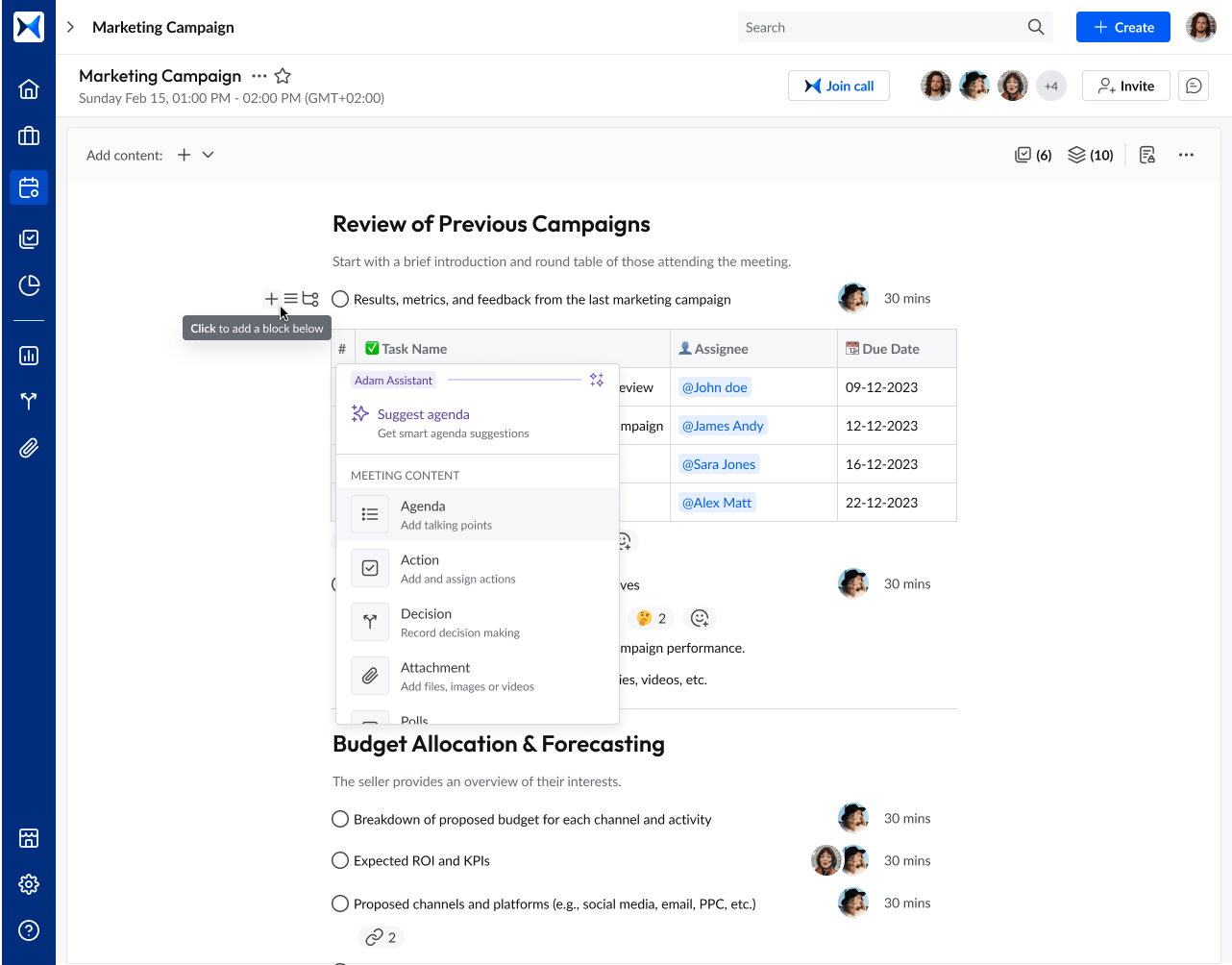
2. Action tracking
This feature ensures continuity by incorporating pending action items from previous meetings into the next agenda, fostering accountability and alignment.
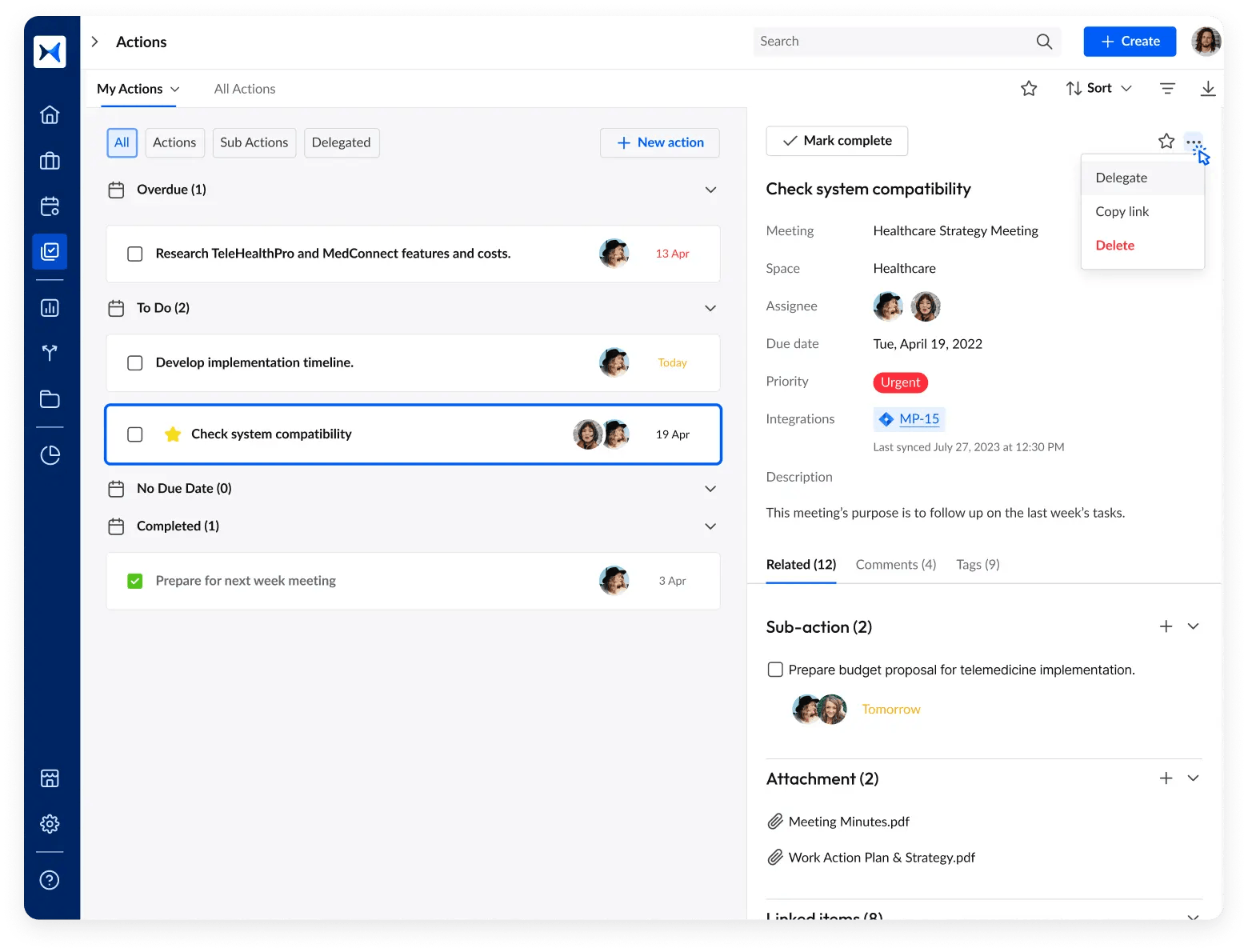
3. Content collaboration
Shared spaces for documents and meeting content make it easy for committees to access relevant data, reports, and proposals. This ensures that agenda topics are well-informed and backed by real-time insights.
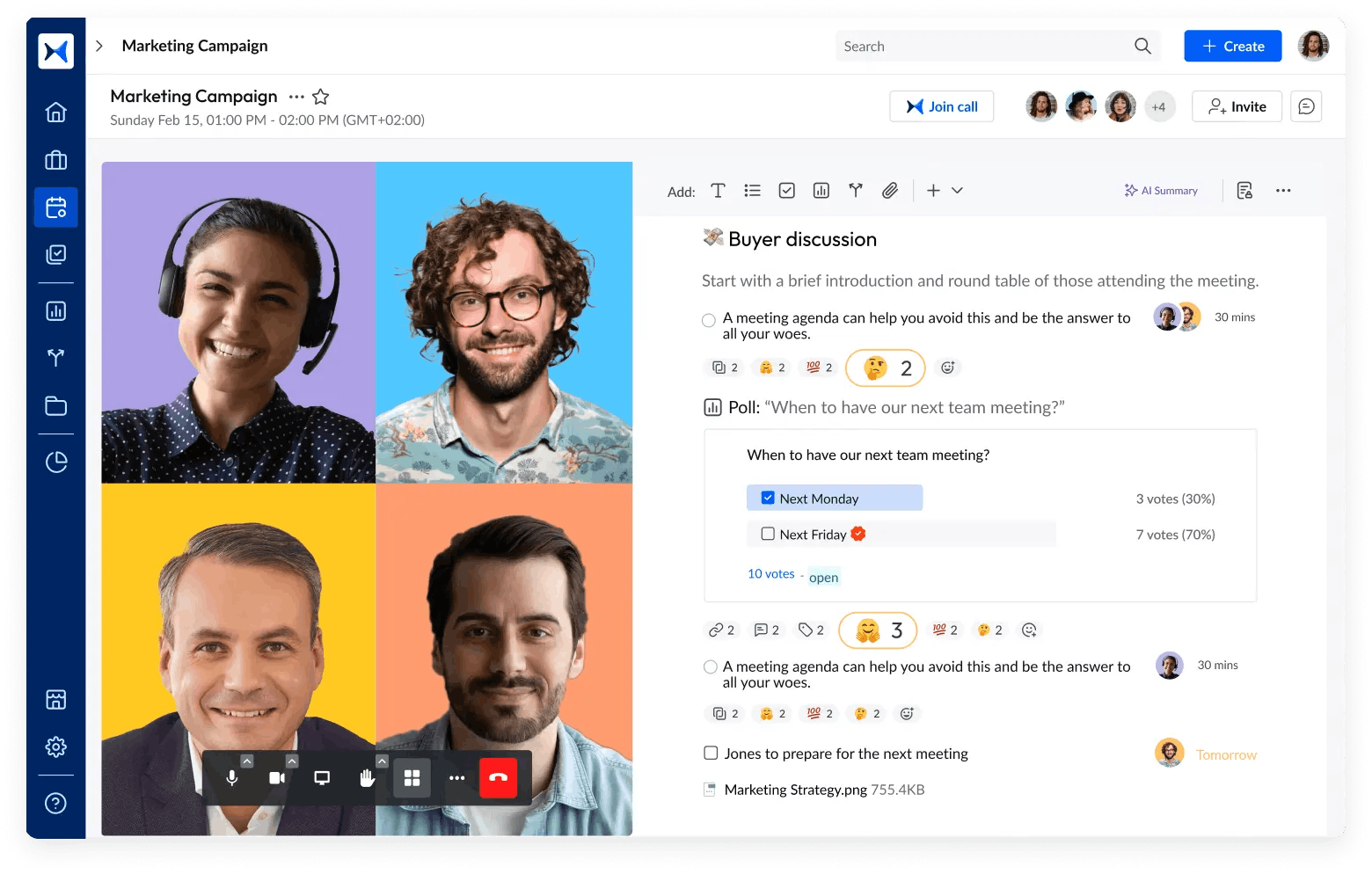
4. Polling
Committees can use polls to gather input from members on agenda priorities or key decisions. This promotes inclusivity by ensuring all members have a voice in shaping the meeting’s focus.
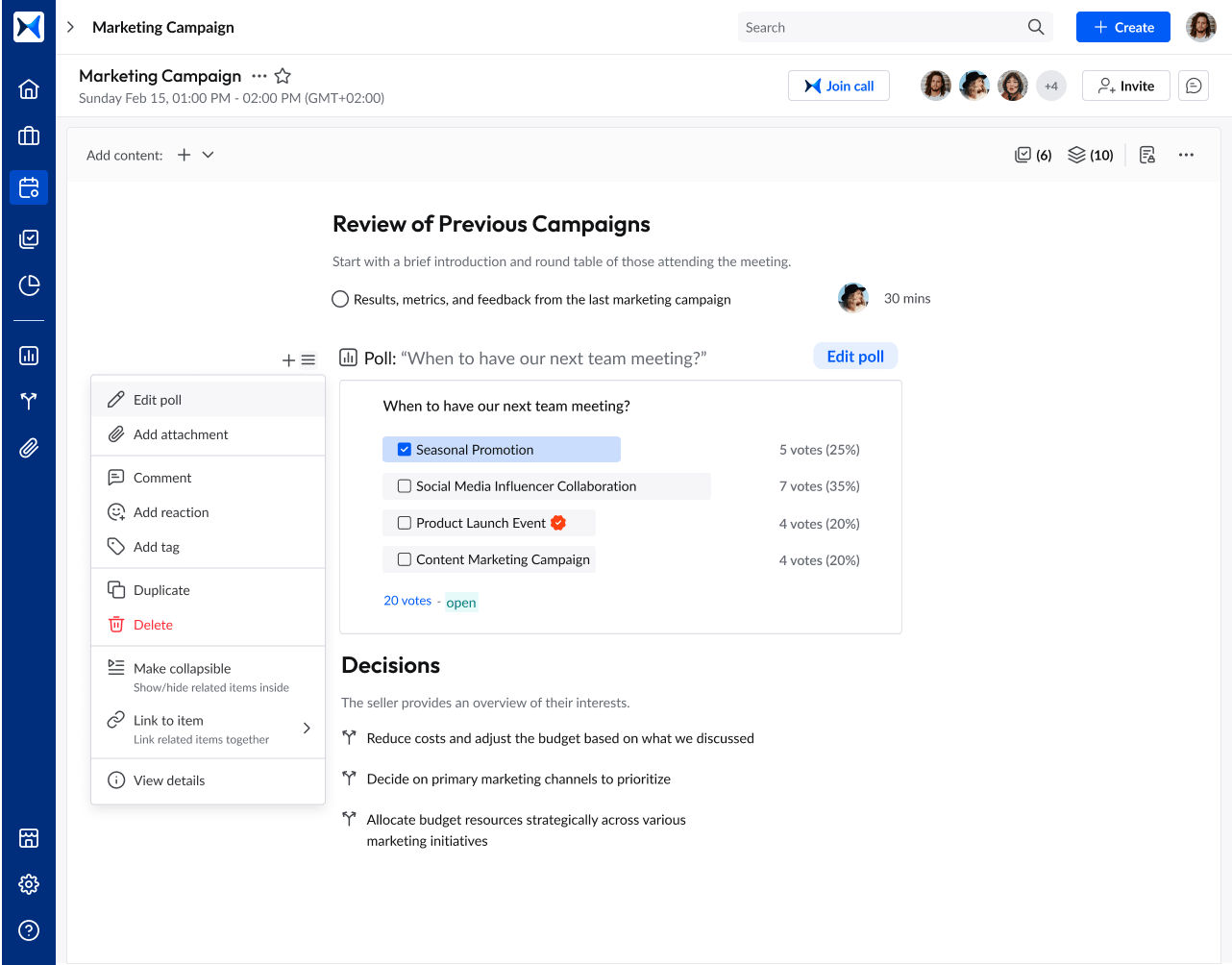
5. Meeting minutes
adam.ai automatically records and organizes meeting minutes, capturing discussions, decisions, and key points. These minutes serve as a reliable source of data for setting future agendas and tracking progress over time.
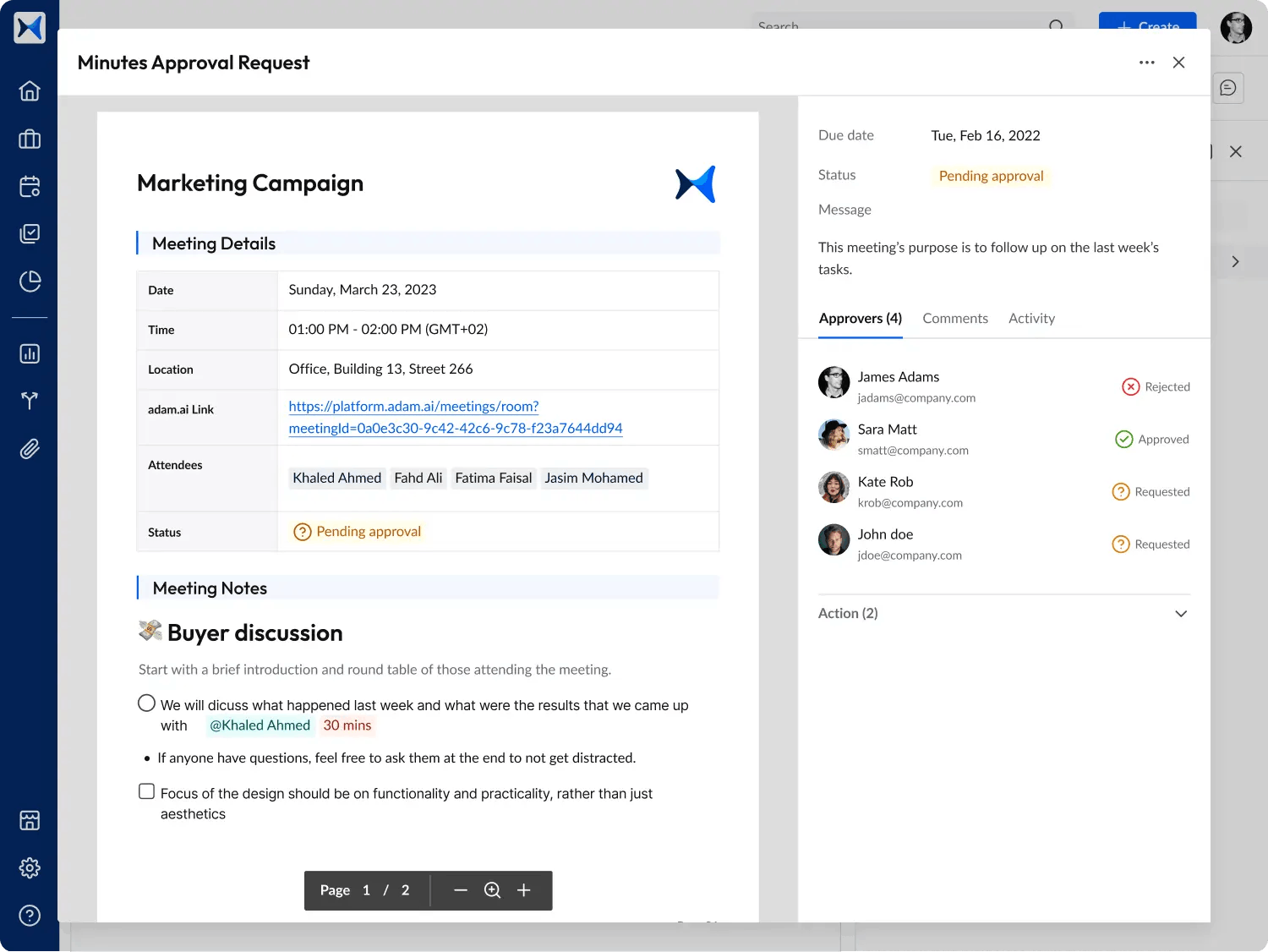
6. Analytical dashboards
Committees can leverage analytical dashboards to evaluate past meeting performance, including metrics like attendance, engagement, and decision-making outcomes. This data helps refine agenda items and align them with the committee’s objectives.
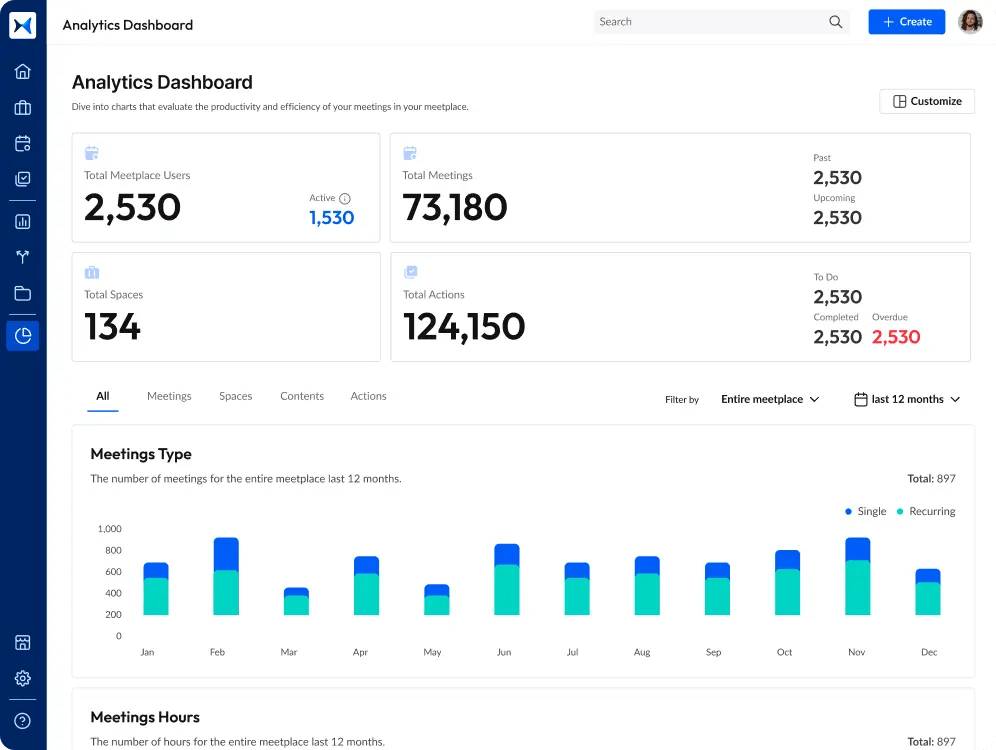
Transform how you conduct critical meetings—From meticulous preparation to effective execution and insightful follow-up, adam.ai integrates comprehensive analytics, full customization, and intuitive interfaces with powerful meeting management tools.
Easy onboarding. Enterprise-grade security. 24/7 dedicated support.
The bottom line
Data-driven approaches revolutionize how committees operate, turning meetings into strategic sessions with measurable outcomes. By utilizing modern tools, committees can foster collaboration, ensure accountability, and achieve their objectives with precision.
And while there may be multiple meeting management solutions available, here is why adam.ai is the board management software platform you can trust:
- adam.ai is one of Atlassian Ventures' portfolio companies.
- In the meeting management software category on G2, adam.ai has been ranked a leader and a high performer for successive quarters in the past years.
- adam.ai has been included in the Forrester Report in the AI-enabled meeting technology landscape.
- adam.ai is trusted and used by powerful teams and organizations worldwide for all types of critical meetings, like board, committee, project management, and business development meetings.
- And most importantly, adam.ai integrates with your existing workflow, is SOC2 compliant, provides dedicated support and success, and has a free trial option.
Subscribe to adam.ai blog
Stay ahead with the latest insights—get our newest blog posts, tips, and updates sent straight to your inbox.